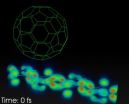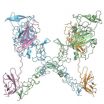(Press-News.org) LOS ANGELES – (May 30, 2014) – Green tea and its extracts have been widely touted as potential treatments for cancer, as well as several other diseases. But scientists have struggled to explain how the green tea and its extracts may work to reduce the risk of cancer or to slow the growth of cancer cells.
A study recently published online by the journal, Metabolomics, offers an explanation that researchers say could open a new area of cancer-fighting research. The study reports that EGCG, the active biologic constituent in green tea, changed the metabolism of pancreatic cancer cells by suppressing the expression of an enzyme associated with cancer, LDHA.
The researchers also found an enzyme inhibitor, oxamate, which is known to reduce LDHA activity, operated in the same manner: It also disrupted the pancreatic cancer cells metabolic system.
"Scientists had believed they needed a molecular mechanism to treat cancer, but this study shows that they can change the metabolic system and have an impact on cancer," said Wai-Nang Lee, MD, corresponding author of the study and a Los Angeles Biomedical Research Institute (LA BioMed) lead researcher. "By explaining how green tea's active component could prevent cancer, this study will open the door to a whole new area of cancer research and help us understand how other foods can prevent cancer or slow the growth of cancerous cells."
Using sophisticated metabolic profiling methods, the researchers found EGCG disrupted the balance of "flux" throughout the cellular metabolic network. Flux is the rate of turnover of molecules through a metabolic pathway. The researchers found the EGCG disrupted this balance in the same manner that oxamate, a known LDHA inhibitor, did.
Based on this finding, they concluded that both EGCG and oxamate reduced the risk of cancer by suppressing the activity of LDHA, a critical enzyme in cancer metabolism, thereby disrupting the balance in the cancer cells metabolic functions.
"This is an entirely new way of looking at metabolism," said Dr. Lee. "It is no longer a case of glucose goes in and energy comes out. Now we understand how cancer cell metabolism can be disrupted, and we can examine how we can use this knowledge to try to alter the course of cancer or prevent cancer."
INFORMATION:
About LA BioMed
Founded in 1952, LA BioMed is one of the country's leading nonprofit independent biomedical research institutes. It has approximately 100 principal researchers conducting studies into inherited diseases, infectious diseases, illnesses caused by environmental factors and more. It also educates young scientists and provides community services, including prenatal counseling and childhood nutrition programs. LA BioMed is academically affiliated with the David Geffen School of Medicine at UCLA and located on the campus of Harbor-UCLA Medical Center. For more information, please visit http://www.LABioMed.org
Study explains how green tea could reduce pancreatic cancer risk
Findings open a new area for research into cancer prevention
2014-05-30
ELSE PRESS RELEASES FROM THIS DATE:
Research shows overall survival benefit for patients with Stage III soft tissue sarcomas
2014-05-30
CHICAGO, IL (May 30, 2014)—Fox Chase Cancer Center researchers have carried out the first retrospective analysis of adjuvant chemotherapy's impact on overall survival in patients with stage III soft tissue sarcomas (STS), adjusted for socioeconomic status and other variables. The findings show that regardless of socioeconomic status and comorbidities, adjuvant chemotherapy improved survival by approximately 23 percent in stage III STS. Study leader Sujana Movva, MD, Medical Oncologist at Fox Chase, will present the findings the 50th Annual Meeting of the American Society ...
More patients with ovarian cancer are receiving chemotherapy before surgery
2014-05-30
CHICAGO, IL (May 30, 2014)—The use of chemotherapy before surgery to remove ovarian cancer has increased dramatically in recent decades, particularly among certain patients, according to a new analysis from Fox Chase Cancer Center that will be presented at the 50th Annual Meeting of the American Society of Clinical Oncology.
Looking back at medical records from more than 58,000 women, Fox Chase's Angela Jain, MD, Medical Oncologist and co-investigator Elizabeth Handorf, PhD, member of the Biostatistics and Bioinformatics Facility, found that only 8.94% received chemotherapy ...
Compounds in saliva and common body proteins may fend off DNA-damaging chemicals
2014-05-30
A compound in saliva, along with common proteins in blood and muscle, may protect human cells from powerful toxins in tea, coffee and liquid smoke flavoring, according to results of a new study led by investigators at the Johns Hopkins Kimmel Cancer Center.
The findings, reported online May 19 in Food and Chemical Toxicology, suggest that people naturally launch multiple defenses against plant chemicals called pyrogallol-like polyphenols or PLPs found in teas, coffees and liquid smoke flavoring. The presence of these defenses could help explain why PLPs are not crippling ...
New satellite animation shows the end of Hurricane Amanda
2014-05-30
VIDEO:
This animation of visible and infrared imagery from NOAA's GOES-West satellite shows the weakening of Hurricane Amanda from May 28 to its dissipation on May 30.
Click here for more information.
A new animation of visible and infrared imagery from NOAA's GOES-West satellite shows the weakening and dissipation of the Eastern Pacific Ocean's Hurricane Amanda. The animation that runs from from May 28 to May 30 was created at NASA/NOAA's GOES Project at NASA's Goddard Space ...
Hepatitis C reactivation doesn't worsen survival for HIV+ patients diagnosed with lymphoma
2014-05-30
CHICAGO, IL (May 30, 2014)—More than a quarter of HIV+ patients are also infected with the Hepatitis C virus (HCV), which may complicate treatment and care decisions after a cancer diagnosis. The specifics of those complications haven't been well-researched in the past. Results from a new Fox Chase Cancer Center study on this patient population may start filling in that gap.
Fox Chase Hematologist and Medical Oncologist Stefan K. Barta, MD, MS, MRCP – who led the study – analyzed data from HIV+ patients diagnosed with lymphoma, collected over 17 years, to better understand ...
Identification of central nervous system involvement for patients with AIDS-related lymphomas
2014-05-30
CHICAGO, IL (May 30, 2014)—Patients with AIDS-related lymphomas (ARL) may face an increased risk of central nervous system involvement (CNSi) compared to other lymphomas. The effect of CNSi on survival outcomes, however, hasn't been thoroughly examined until now.
In a new study led by Fox Chase Cancer Center Hematologist and Oncologist Stefan K. Barta, MD, MS, MRCP, researchers report that CNSi – identified at the time of an ARL diagnosis – does not appear to have an impact on overall survival. Dr. Barta's collaborators will present the findings at the 50th Annual Meeting ...
Moffitt Cancer Center instrumental in new clinical guidelines for cancer-related fatigue
2014-05-30
TAMPA, Fla. (May 30, 2014) – Fatigue is a debilitating problem for cancer patients undergoing treatment; however, it also poses a huge detriment after treatment and can significantly affect quality of life. Approximately 30 percent of cancer patients endure persistent fatigue for several years after treatment, according to an American Society of Clinical Oncology Expert Panel co-chaired by Paul Jacobsen, Ph.D., associate center director of Population Sciences at Moffitt Cancer Center.
ASCO created the panel to develop assessment, screening, and treatment guidelines for ...
First real time movies of the light-to-current conversion in an organic solar cell
2014-05-30
VIDEO:
Real time quantum simulation of the conversion of light into current in an organic solar cell composed of a polymer chain, and a Fullerene buckyball. The movie lasts for about...
Click here for more information.
Photovoltaic cells directly convert sun light into electricity and hence are key technological devices to meet one of the challenges that mankind has to face in this century: a sustainable and clean production of renewable energy. Organic solar cells, using polymeric ...
Research details how developing neurons sense a chemical cue
2014-05-30
Symmetry is an inherent part of development. As an embryo, an organism's brain and spinal cord, like the rest of its body, organize themselves into left and right halves as they grow. But a certain set of nerve cells do something unusual: they cross from one side to the other. New research in mice delves into the details of the molecular interactions that help guide these neurons toward this anatomical boundary.
In an embryo, a neuron's branches, or axons, have special structures on their tips that sense chemical cues telling them where to grow. The new findings, by ...
Study highlights side effects felt by BRCA mutation carriers after cancer risk-reducing procedure
2014-05-30
PHILADELPHIA — The majority of women with cancer causing BRCA1 and BRCA2 mutations experience sexual dysfunction, menopausal symptoms, cognitive and stress issues, and poor sleep following prophylactic removal of their Fallopian tubes and ovaries - a procedure known as risk-reducing salpingo-oophorectomy (RRSO) - according to results of a new study from the Abramson Cancer Center and the Perelman School of Medicine at the University of Pennsylvania. The team's findings, which reaffirm the need for a better understanding of how to manage long-term effects of the risk-reducing ...
LAST 30 PRESS RELEASES:
New expert guidance urges caution before surgery for patients with treatment-resistant constipation
Solar hydrogen can now be produced efficiently without the scarce metal platinum
Sleeping in on weekends may help boost teens’ mental health
Study: Teens use cellphones for an hour a day at school
After more than two years of war, Palestinian children are hungry, denied education and “like the living dead”
The untold story of life with Prader-Willi syndrome - according to the siblings who live it
How the parasite that ‘gave up sex’ found more hosts – and why its victory won’t last
When is it time to jump? The boiling frog problem of AI use in physics education
Twitter data reveals partisan divide in understanding why pollen season's getting worse
AI is quick but risky for updating old software
Revolutionizing biosecurity: new multi-omics framework to transform invasive species management
From ancient herb to modern medicine: new review unveils the multi-targeted healing potential of Borago officinalis
Building a global scientific community: Biological Diversity Journal announces dual recruitment of Editorial Board and Youth Editorial Board members
Microbes that break down antibiotics help protect ecosystems under drug pollution
Smart biochar that remembers pollutants offers a new way to clean water and recycle biomass
Rice genes matter more than domestication in shaping plant microbiomes
Ticking time bomb: Some farmers report as many as 70 tick encounters over a 6-month period
Turning garden and crop waste into plastics
Scientists discover ‘platypus galaxies’ in the early universe
Seeing thyroid cancer in a new light: when AI meets label-free imaging in the operating room
Neutrophil-to-lymphocyte ratio may aid risk stratification in depressive disorder
2026 Seismological Society of America Annual Meeting
AI-powered ECG analysis offers promising path for early detection of chronic obstructive pulmonary disease, says Mount Sinai researchers
GIMM uncovers flaws in lab-grown heart cells and paves the way for improved treatments
Cracking the evolutionary code of sleep
Medications could help the aging brain cope with surgery, memory impairment
Back pain linked to worse sleep years later in men over 65, according to study
CDC urges ‘shared decision-making’ on some childhood vaccines; many unclear about what that means
New research finds that an ‘equal treatment’ approach to economic opportunity advertising can backfire
Researchers create shape-shifting, self-navigating microparticles
[Press-News.org] Study explains how green tea could reduce pancreatic cancer riskFindings open a new area for research into cancer prevention



